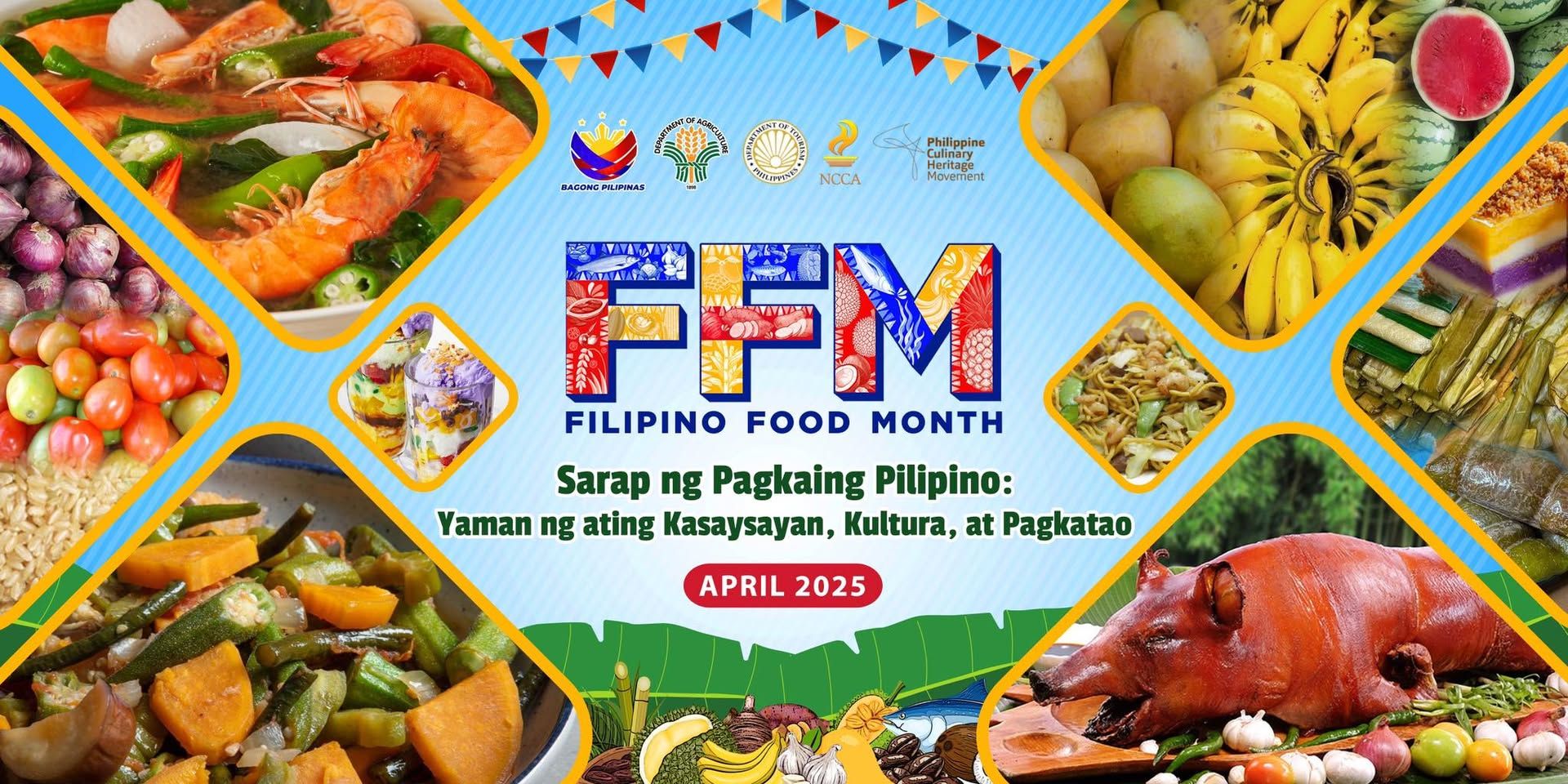6 Hard-Hitting Truths From This Year’s Filipino Food Month
ADVERTISEMENT

Welcome, Kapamilya! We use cookies to improve your browsing experience. Continuing to use this site means you agree to our use of cookies. Tell me more!
6 Hard-Hitting Truths From This Year’s Filipino Food Month
Metro.Style Team
Published May 01, 2025 06:50 AM PHT
|
Updated May 02, 2025 06:51 AM PHT
Filipino Food Month 2025, celebrated throughout April, brought a festive spotlight to the Philippines’ culinary heritage, but its conclusion reveals hard truths and vital lessons about the nation’s food culture.
Filipino Food Month 2025, celebrated throughout April, brought a festive spotlight to the Philippines’ culinary heritage, but its conclusion reveals hard truths and vital lessons about the nation’s food culture.
This year’s theme, “Sarap ng Pagkaing Pilipino, Yaman ng Ating Kasaysayan, Kultura at Pagkatao” (The Deliciousness of Filipino Food, the Wealth of Our History, Culture, and Identity), positioned food as a cultural ambassador. Drawing from events, initiatives, and reflections during the month, here are five key learnings and concerns that emerged, a deeper understanding of Filipino cuisine’s past, present, and future.
This year’s theme, “Sarap ng Pagkaing Pilipino, Yaman ng Ating Kasaysayan, Kultura at Pagkatao” (The Deliciousness of Filipino Food, the Wealth of Our History, Culture, and Identity), positioned food as a cultural ambassador. Drawing from events, initiatives, and reflections during the month, here are five key learnings and concerns that emerged, a deeper understanding of Filipino cuisine’s past, present, and future.
 Filipino Food Month 2025
Filipino Food Month 2025
 Filipino Food Month 2025
Filipino Food Month 20251. Preserving indigenous cuisines is a race against time.
Chef Jam Melchor, founder of the Philippine Culinary Heritage Movement (PCHM), highlighted the urgency of preserving indigenous Filipino cuisines, which are at risk of disappearing due to globalization and modernization. During Filipino Food Month, Melchor’s efforts focused on documenting and reviving dishes from communities like the Aeta, whose traditional ingredients and techniques are fading.
Chef Jam Melchor, founder of the Philippine Culinary Heritage Movement (PCHM), highlighted the urgency of preserving indigenous Filipino cuisines, which are at risk of disappearing due to globalization and modernization. During Filipino Food Month, Melchor’s efforts focused on documenting and reviving dishes from communities like the Aeta, whose traditional ingredients and techniques are fading.
This highlights the need to seek out authentic, community-driven culinary experiences, like those in Pampanga or Iloilo, before they disappear. The concern is evident: without dedicated preservation efforts, the vibrant diversity of indigenous flavors risks fading, resulting in a uniform culinary landscape.
This highlights the need to seek out authentic, community-driven culinary experiences, like those in Pampanga or Iloilo, before they disappear. The concern is evident: without dedicated preservation efforts, the vibrant diversity of indigenous flavors risks fading, resulting in a uniform culinary landscape.
ADVERTISEMENT
 Chef Jam Melchor with his book, Kayumanggi | Photo: Jeeves De Veyra
Chef Jam Melchor with his book, Kayumanggi | Photo: Jeeves De Veyra
 Chef Jam Melchor with his book, Kayumanggi | Photo: Jeeves De Veyra
Chef Jam Melchor with his book, Kayumanggi | Photo: Jeeves De Veyra2. Culinary heritage is a story of adaptation.
The revival of Bruun-style compound butter by Roberto “Rob” Villacabral of the Histólinarya Collective showcased how Filipino cuisine evolves through cultural exchange. At a workshop titled “Whisking Thru Tradition” in Rockwell, Villacabral recreated this Danish-influenced butter, used in 1930s-style ensaymadas and lengua de gato, demonstrating the Philippines’ ability to localize foreign influences. This adaptation is a hallmark of Filipino food, seen in dishes like ensaymada, which transformed from its Spanish origins to include egg yolks and Edam cheese. This ‘fusion’ has occurred in many dishes across the archipelago, but the concern remains that the stories behind these adaptations are often unrecorded and risk being forgotten without efforts like Villacabral’s.
The revival of Bruun-style compound butter by Roberto “Rob” Villacabral of the Histólinarya Collective showcased how Filipino cuisine evolves through cultural exchange. At a workshop titled “Whisking Thru Tradition” in Rockwell, Villacabral recreated this Danish-influenced butter, used in 1930s-style ensaymadas and lengua de gato, demonstrating the Philippines’ ability to localize foreign influences. This adaptation is a hallmark of Filipino food, seen in dishes like ensaymada, which transformed from its Spanish origins to include egg yolks and Edam cheese. This ‘fusion’ has occurred in many dishes across the archipelago, but the concern remains that the stories behind these adaptations are often unrecorded and risk being forgotten without efforts like Villacabral’s.
3. Food Is a cultural ambassador.
Events like KainCon, the academic food research conference on April 12, and the Hapag ng Pamana culinary heritage forum in Capiz and Iloilo demonstrated the importance of showcasing the regional flavors of Filipino cuisine, from Bicol’s spicy dishes to Cordillera’s heirloom recipes. These initiatives, supported by organizations like the National Commission for Culture and the Arts, highlight food’s role as a gateway to understanding Filipino culture, drawing visitors to explore local markets and festivals. However, a concern arises: the focus on tourism must not overshadow the need to support local farmers and producers, who are the backbone of these culinary experiences, to ensure sustainability.
Events like KainCon, the academic food research conference on April 12, and the Hapag ng Pamana culinary heritage forum in Capiz and Iloilo demonstrated the importance of showcasing the regional flavors of Filipino cuisine, from Bicol’s spicy dishes to Cordillera’s heirloom recipes. These initiatives, supported by organizations like the National Commission for Culture and the Arts, highlight food’s role as a gateway to understanding Filipino culture, drawing visitors to explore local markets and festivals. However, a concern arises: the focus on tourism must not overshadow the need to support local farmers and producers, who are the backbone of these culinary experiences, to ensure sustainability.
 KainCon 2025
KainCon 2025
 KainCon 2025
KainCon 2025 4. Regional diversity needs greater recognition.
4. Regional diversity needs greater recognition.
Filipino Food Month 2025 celebrated the archipelago’s culinary diversity through events like the Mangan Taku Cordillera Food Fair in Baguio and the Filipino Food Month Fair in Camarines Sur. These showcased regional specialties, yet voices raised a critical question: whose food is being celebrated? The spotlight often falls on popular dishes like adobo or sinigang, sidelining lesser-known regional and indigenous cuisines. We need to venture beyond Manila to places like Iloilo, a UNESCO Creative City of Gastronomy, lest the unequal representation marginalize the culinary contributions of smaller communities.
Filipino Food Month 2025 celebrated the archipelago’s culinary diversity through events like the Mangan Taku Cordillera Food Fair in Baguio and the Filipino Food Month Fair in Camarines Sur. These showcased regional specialties, yet voices raised a critical question: whose food is being celebrated? The spotlight often falls on popular dishes like adobo or sinigang, sidelining lesser-known regional and indigenous cuisines. We need to venture beyond Manila to places like Iloilo, a UNESCO Creative City of Gastronomy, lest the unequal representation marginalize the culinary contributions of smaller communities.
5. Education and storytelling are key to preservation.
5. Education and storytelling are key to preservation.
ADVERTISEMENT
Initiatives like Villacabral’s 18-page workshop booklets, which pair recipes with culinary research, and Melchor’s advocacy for food education programs, such as those launched on April 7 at the Department of Agriculture’s Central Office, emphasized the power of storytelling in preserving culinary heritage. These efforts teach not just how to cook but why dishes matter, connecting recipes to history and identity. There’s a need to engage more with culinary historians to understand the context behind dishes. Without sustained educational efforts, younger generations may lose touch with their culinary roots, diminishing the cultural depth of Filipino cuisine.
Initiatives like Villacabral’s 18-page workshop booklets, which pair recipes with culinary research, and Melchor’s advocacy for food education programs, such as those launched on April 7 at the Department of Agriculture’s Central Office, emphasized the power of storytelling in preserving culinary heritage. These efforts teach not just how to cook but why dishes matter, connecting recipes to history and identity. There’s a need to engage more with culinary historians to understand the context behind dishes. Without sustained educational efforts, younger generations may lose touch with their culinary roots, diminishing the cultural depth of Filipino cuisine.
6. Poverty shapes culinary resourcefulness but demands action.
Chef Waya Wijangco’s reflections on Filipino Food Month reveal a stark truth: the ingenuity of Filipino cuisine often stems from poverty, with cooks stretching limited resources—like a single chicken across multiple servings or leftovers transformed into new meals. While the Philippines produces world-class ingredients such as cacao and mangoes, many farmers and producers cannot afford nutritious meals themselves, highlighting a disconnect between abundance and access. This underscores the importance of supporting local, sustainable food systems, such as carinderias and markets. The concern is pressing: celebrations of culinary heritage must also address systemic issues like inflation and food insecurity to ensure all Filipinos can share in the feast.
Chef Waya Wijangco’s reflections on Filipino Food Month reveal a stark truth: the ingenuity of Filipino cuisine often stems from poverty, with cooks stretching limited resources—like a single chicken across multiple servings or leftovers transformed into new meals. While the Philippines produces world-class ingredients such as cacao and mangoes, many farmers and producers cannot afford nutritious meals themselves, highlighting a disconnect between abundance and access. This underscores the importance of supporting local, sustainable food systems, such as carinderias and markets. The concern is pressing: celebrations of culinary heritage must also address systemic issues like inflation and food insecurity to ensure all Filipinos can share in the feast.
Filipino Food Month 2025 was a celebration of flavors and a call to action.
Filipino Food Month 2025 was a celebration of flavors and a call to action.
Lead photo: Eiliv Aceron on Unsplash
Read More:
filipino food month
philippine culinary heritage
ncca
department of agriculture
dot
sustainability
filipino food festivals
foodbymetro
ADVERTISEMENT
ADVERTISEMENT


